In 1864, Walter Campbell was an officer in the British Army, stationed in India when he penned these words in his journal: “Never attack a tiger on foot—if you can help it. There are cases in which you must do so. Then face him like a Briton, and kill him if you can; for if you fail to kill him, he will certainly kill you.”
In a stroke of good fortune for the tiger, perceptions in India have changed drastically since Campbell’s time. Tiger hunting is now banned and conservationists are usually able to rescue the big cats if they become stranded while navigating increasingly human-occupied areas. But is this enough to save the tiger?
The tiger and Indian history
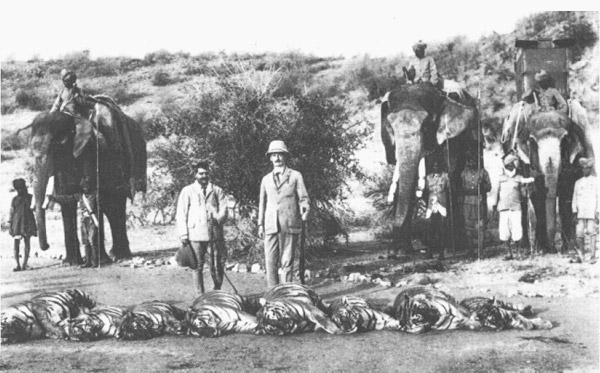
The Viceroy of India, Lord Reading, hunts multiple tigers in one sitting. Photo credit: CBSE textbook.
The British were not the first to hunt tigers for sport; that distinction rests with the Mughal emperors that ruled India from the 16th to 19th centuries. The British, arriving on the tails of the Mughal Empire, emulated the Mughal emperors for whom tiger hunting was a demonstration of the right to a kingship.
Jehangir, the eldest son of Mughal emperor Akbar, kept detailed records of his kills: over a 36-year period, he personally hunted 17,167 animals, 80 of which were tigers. Indian nobility soon took up the hunt with renewed vigor. Renowned conservationist George Schaller once received a letter from the Maharaja of Surguja claiming to have killed 1,150 tigers himself by 1965. Together, the British and the Mughals systematically decimated tiger populations in India, while similar scenarios played out across the rest of the tiger’s range.
“At the close of the 19th century, when Rudyard Kipling penned the Jungle Book, between 50,000 and 100,000 tigers were thought to roam the Indian subcontinent,” reports Sharon Gunyup for National Geographic’s Cat Watch. “By 1971, about 1,800 were left alive and the Tiger Task Force predicted they would be extinct by the end of the century.”
Due in part to a ban on tiger killing by a Delhi High court in 1971—despite a burgeoning trophy hunting industry—tigers are still alive in the wild today, but just barely.
Where tigers roam

Tiger in Tadoba-Andhari Tiger Reserve in the state of Maharashtra. Photo by: Morgan Erickson-Davis.
In 2010, the Global Tiger Recovery Program estimated that there are roughly 4,000 adult tigers alive in the wild, squeezed into a mere fraction of their historical range. Of these, the IUCN Redlist calculates that just under half (1,706) reside in India today.
Analyses of tiger DNA revealed that Indian tigers contain over half the genetic diversity of all tigers today. As such, India is considered a stronghold for tiger conservation, with the largest number (40 of 76) of Tiger Conservation Landscapes (TCL) in the world.
According to the Wildlife Conservation Society’s Tiger Action Plan for 2005-2015, these landscapes are core areas interconnected by corridors, allowing tigers to disperse naturally. Although the total area covered by the 76 TCLs is large (1,185,000 square kilometers), it covers only about seven percent of the historical range of the tiger. Moreover, protected areas cover only 23 percent of this tiger landscape.
“What we may witness over the coming decade,” reports the WCS in its Tiger Action Plan, “is the winking out of tiger populations if habitat continues to be degraded or converted, if tiger prey is decimated, and if poaching pressure on tigers and their prey is not eliminated.”
When asked what the greatest threat facing wild tigers is today, Joe Walston, the Executive Director of WCS’s Asia Programs stated simply: “Poaching, both of the tigers themselves and also of their prey.”
A 2008 survey of urban Chinese citizens found that 43 percent had consumed some product allegedly containing tiger parts, with 71 percent of those surveyed preferring wild products to farmed ones. This is despite the fact that 88 percent of respondents reported being aware of the illegality of buying or selling tiger products. In fact, in a dazzling display of human logic, all but seven percent of respondents agreed that a ban in trade in tiger parts was necessary to conserve the tiger, while simultaneously seeking out medicinal products with “wild” tiger parts.
Tigers in human landscapes
The question of whether tigers can live in human dominated landscapes has been the cause of many arguments among scientists, conservationists and people living near tigers. Undoubtedly, these heated arguments are justified, for tigers are denigrated for human deaths in India, while simultaneously representing the grandeur and power of wild India.
One study conducted at the Tadobha-Andhari Tiger Reserve in Chandrapur District of central India reported 103 tiger and 29 leopard attacks on humans from 2005 to 2011. Fifty-four percent of these were lethal.
 A compilation of camera trap images of female tiger, Kala, obtained over the year she was monitored. Photo compilation provided by Aditya Josh. |
Attacks occurred most often in the forested outskirts of the reserve, while most victims were crouched low, collecting minor forest products. Victims were of all ages (9-65), but only 21 percent of the bodies were even partially consumed. Of the 115 attacks for which eyewitnesses were available, only 13 percent occurred when the victim harassed the animal.
“Human–carnivore conflicts,” concluded the authors of the study “tend to be more frequent near forest edges at the interface of human and carnivore activity, and in areas of high human density.”
“There is no room for error and certainly no room for sentimentality,” said Joe Walston in an interview for WCS, reflecting on the future of tiger conservation in India. “Visions of vast landscapes where man and beast live side by side are naïve, especially where apex predators like tigers are concerned. We need to give tigers their dedicated space and to make these areas inviolate.”
While this could be the ideal way to protect the tiger, it appears that tigers do not restrict their movements to national parks alone. One male tiger walked out of the Bandipur Tiger Reserve in south India through heavily populated areas before wildlife officials captured it in a village 280 kilometers (174 miles) away. A team of scientists led by Aditya Joshi of the National Center for Biological Sciences (NCBS) in Bangalore then examined scat collected from across the nation’s parks. They found that dispersal was occurring between parks separated by over 690 kilometers (430 miles).
It appears as though the question of whether tigers could live in human landscapes has answered itself: they already do.
Kala’s story
The story of one female tiger, Kala, highlights the particular complexity of interactions between humans and tigers in India. On October 12th, 2011, villagers informed a local forest officer that a tiger was trapped in an irrigation canal duct and had been there since the early that morning. The news traveled up the Forest Department grapevine, and by 2 pm, Dr. Suresh Kumar Khetarpal, the Principal Chief Conservator of Forests (PCCF) and Chief Wildlife Warden of the State, made the decision to capture the tiger (see photos of rescue below).
“The operation started at about 4 PM and continued till dusk, [but] the forest department had little success in bringing out the trapped tigress,” Khetarpal told mongabay.com.
The rescue eventually had to be abandoned and attempted the next morning, during which time the tigress was monitored in the canal. She was a healthy animal, most likely quite young, since it was later determined that she had not had cubs yet. She appeared to have some facial injuries incurred during her attempts to get out of the deep culvert. Officials named her Kala.
 Kala, the rescued tigress, being outfitted with a GPS collar prior to release. Photo by: Aditya Joshi. |
Roheet Karoo, founder of the Wildlife Conservation and Development Centre (WLCDC) and Honorary Wildlife Warden of Nagpur district, was present during the rescue and documented it closely. Dr Gautam Bhojane from Nagpur Veterinary Hospital and ACF Kishor Mishrikotkar tranquilized the animal and slowly raised her out of the culvert.
Due to Kala’s injuries from her frantic efforts to exit the culvert overnight, she was kept for 45 days to heal in a secluded enclosure with next to no human contact. Before her release, Khetarpal contacted Vidya Athreya, a wildlife ecologist with a penchant for cats in human landscapes. Together, they arranged for Kala to be fitted with a GPS collar, which would use neighboring cell towers to signal her location to researchers at set time intervals. On November 27th, 2011 she was released in a forest patch about six kilometers from her capture site.
This would not be the first time a big cat was monitored by GPS tracking in India. According to Athreya, lions, tigers, and leopards are currently being monitored during reintroductions to National Parks by researchers at the Wildlife Institute of India. However, Kala’s rescue and release were unusual in that they occurred in highly human-dominated landscapes: the population density in the area was calculated to be 409 people per square kilometer, with one village occurring every 5.3 square kilometers.
“This is first time a rescued tiger has been fitted with a collar and monitored so closely in a human landscape,” Athreya explained. The results of over a year of monitoring were published in mongabay.com’s open access journal Tropical Conservation Science.
Athreya and colleagues collected 1,358 hourly coordinates of the tigress’s position until the collar’s battery died in March 2012. Soon after she moved away from a resting site, they visited it to collect information on habitat, visibility, and signs of her presence, such as kills.
Kala traveled a minimum distance of 454 kilometers during this period, spending time in forested and non-forested areas, including agricultural fields and scrub around irrigation canals. She used a range of 720 to 920 square kilometers during this time.
“Although the home range of the tigress encompassed numerous villages,” report the authors in their study, “she rarely came near any village borders. Only three (0.2 percent) out of 1,323 locations used in the movement analyses were closer than 100 meters, and only 3.5 percent were closer than 250 meters from villages.”
Kala was most active from about 7:30 pm till 2:30 am each day. Based on kills found near her resting sites, she ate everything from goats to wild pigs to langurs (monkeys), and even scavenged from cows. Camera trap records show a minimum of 15 tigers in the area during that time. It appears that Kala is also there to stay—she was caught on camera, alive and healthy, 1.5 years after the study ended.
The focus of tiger research until now has been on animals within protected areas where human presence is typically minimal.
“In this landscape, tigers have been present as long as people have,” Arthreya explained. According to her, interactions between humans and cats can range from worship to attacks, with the most common form of interaction being neutral, which has not been studied in great detail.
“All I can say is that we understand so little about human-large cat interactions and most of the dominant discourse is based on opinions,” Athreya asserted.
“Ultimately, the value humans place on tigers roaming free in the wild will decide whether tigers persist in the future,” writes John Seidensticker, the Chairman of the Save the Tiger Fund Council, in the WCS Tiger Action Plan. “People save what they value. To secure a place for wild tigers in our world, live tigers must be worth more to people than tiger parts, and landscapes with tigers must be worth more to people than landscapes where tigers are extinct.”
Rescue of Kala in Photos

The drainage culvert of a canal of the Gosikhurd Dam in which Kala, the tigress, was found trapped on 12th October 2011. Photo by: Roheet Karoo.

Kala, the tigress attempting to exit through blocked drain covers in the culvert in which she was trapped. Photo by: Roheet Karoo.

Wildlife veterinarian, Dr. Gautam Bhojane, from Nagpur Veterinary Hospital loads a tranquilizer dart into a gun for administration to Kala. Photo by: Roheet Karoo.

Kala shows evidence of wounds on her face from attempts to exit the deep culvert in which she was trapped. Photo by Roheet Karoo.
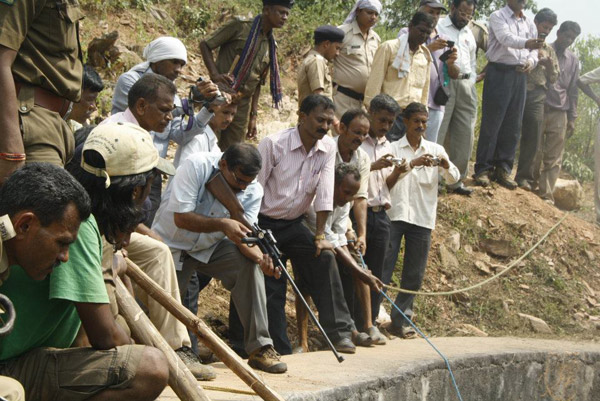
A tiger rescue is a public affair as people crowd around the veterinarian taking aim with a tranquiliser dart. Photo by: Roheet Karoo.

Kala resting after being darted (dart visible in the bottom right of the image). Photo by: Roheet Karoo.
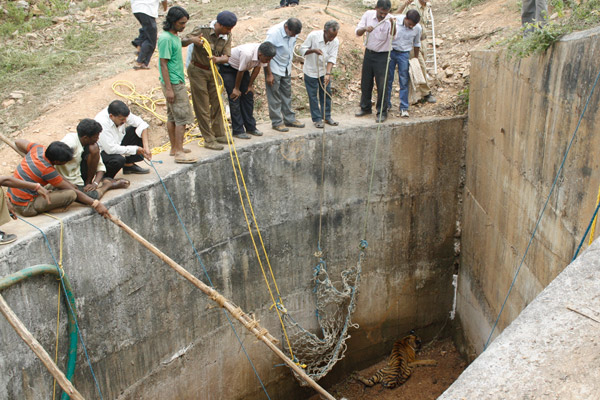
A net is carefully lowered onto the recumbent tigress as she succumbs to the anesthetic. Photo by Roheet Karoo.
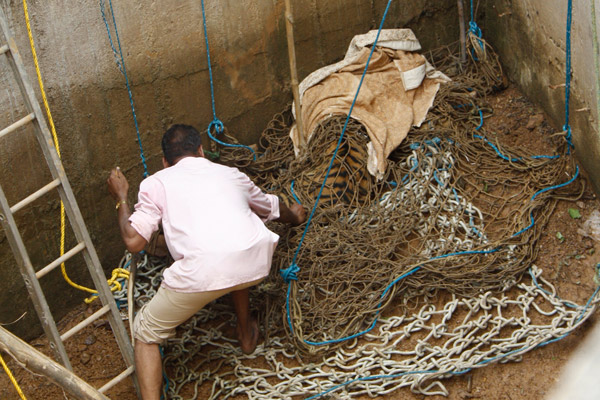
The tigress is given a second small dose of anesthetic to ensure her complete oblivion to the rest of the rescue. Photo by Roheet Karoo.

The tigress is carefully lifted out of the culvert in a net. Photo by Roheet Karoo.
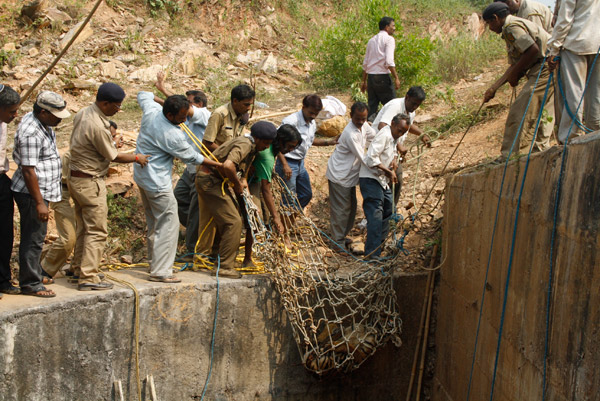
It takes a whole group to lift her to ground level. Photo by Roheet Karoo.
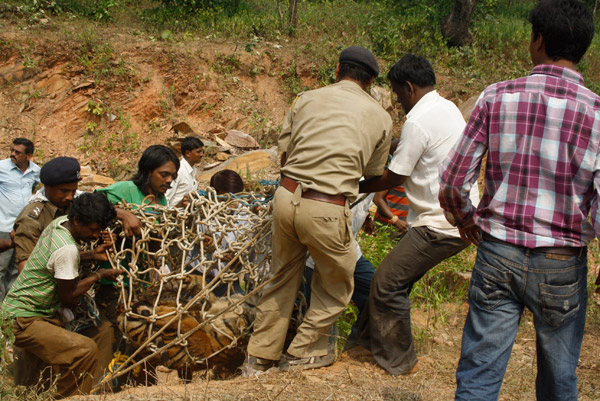
She is then transferred in the net to a waiting van. Photo by Roheet Karoo.
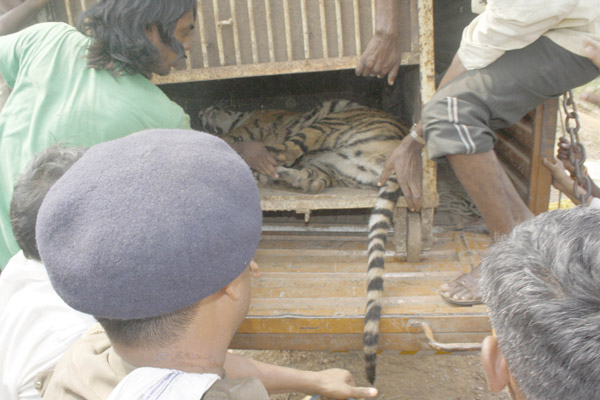
Officials ensure that she is safely placed in a specially constructed cage for transportation to an area where she will be quarantined. Photo by Roheet Karoo.

A crowd has gathered and they watch the van drive off with the tigress. Photo by Roheet Karoo.
Citations:
- Athreya, Vidya, Navya, R., Punjabi, Girish A., Linnell, John D. C., Odden, Morten, Khetarpal, Suresh K., and Karanth, K. Ullas. Movement and activity pattern of a collared tigress in a human-dominated landscape in central India. Tropical Conservation Science 7, no. 1(2014): 75-86.
- Dhanwatey, Harshawardhan S., Joanne C. Crawford, Leandro AS Abade, Poonam H. Dhanwatey, Clayton K. Nielsen, and Claudio Sillero-Zubiri. “Large carnivore attacks on humans in central India: a case study from the Tadoba-Andhari Tiger Reserve.” Oryx 47, no. 02 (2013): 221-227.
- Gratwicke, Brian, Judy Mills, Adam Dutton, Grace Gabriel, Barney Long, John Seidensticker, Belinda Wright, Wang You, and Li Zhang. “Attitudes toward consumption and conservation of tigers in China.” PLoS One 3, no. 7 (2008): e2544.
- Mondol, Samrat, K. Ullas Karanth, and Uma Ramakrishnan. “Why the Indian subcontinent holds the key to global tiger recovery.” PLoS genetics 5, no. 8 (2009): e1000585.
Related articles
The power of connections: India to establish Asia’s largest protected forest

(03/21/2014) India has stepped up forest conservation efforts in recent years, with a major project underway to establish a large swath of uninterrupted habitat through the designation of additional protected areas and expanding those already under protection. If realized, these areas would converge to become Asia’s largest unbroken forest, encompassing approximately 15,000 square kilometers (5,790 square miles) over three states.

(02/25/2014) In May 2011, a young male Bengal tiger (Panthera tigris tigris) made its way to a village in the state of Karnataka in India. The tiger had been quite a hiker. To reach the village, it had walked more than 280 kilometers (174 miles) from Bandipur Tiger Reserve, a protected area famous for these elusive big cats.
Obama announces new strategy to tackle wildlife trafficking, including toughening ivory ban
(02/12/2014) Yesterday, the Obama administration announced an ambitious new strategy to help tackle the global illegal wildlife trade, including a near-complete ban on commercial ivory. The new strategy will not only push over a dozen federal agencies to make fighting wildlife trafficking a new priority, but will also focus on reducing demand for wildlife parts and actively engaging the international community. The U.S. is the world’s second largest destination for illegal wildlife trafficking after China.
Proposed rail and road projects could devastate Nepal’s tigers and rhinos
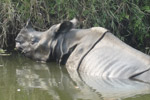
(02/06/2014) Chitwan National Park is a conservation success story. Since its establishment in 1973 the park’s populations of both Bengal tigers (Panthera tigris tigris) and one-horned rhinos (Rhinoceros unicornis) have quintupled, a success achieved during a time when both species have been under siege globally by poachers. A UNESCO World Heritage site, the park is also a vital economic resource for locals: last year the park admitted over 150,000 tourists who brought in nearly $2 million in entry fees alone. But all this is imperiled by government plans for a new railway that would cut the park in half and a slew of new roads, according to a group of international conservationists known as the Alliance of Leading Environmental Researchers and Thinkers (ALERT).
Endangered tiger killed in Sumatra
(02/01/2014) A young Sumatran Tiger (Panthera tigris sumatrae) was shot and killed by a coffee farmer in Jambi Province. With an estimated 400 individuals left in the wild, the species is Critically Endangered, while habitat loss increasingly forces them into populated areas to search for food.
Predator appreciation: how saving lions, tigers, and polar bears could rescue ourselves

(01/29/2014) In the new book, In Predatory Light: Lions and Tigers and Polar Bears, authors Elizabeth Marshall Thomas, Sy Montgomery, and John Houston, and photographers Cyril Christo and Marie Wilkinson share with us an impassioned and detailed appeal to appreciate three of the world’s biggest predators: lions, tigers, and polar bears. Through lengthy discussions, combining themes from scientific conservation to local community folklore, In Predatory Light takes us step by step deeper into the wild world of these awe-inspiring carnivores and their varied plight as they facedown extinction.
German government gives tigers $27 million
(01/14/2014) At a summit in 2010, the world’s 13 tiger range states pledged to double the number of tigers (Panthera tigris) in the wild by 2020. Today, non-tiger state Germany announced its assistance toward that end. Through its KfW Development Bank, the German government has pledged around $27 million (20 million Euro) to a new program run by the International Union for Conservation of Nature.
Indonesia police nab illegal wildlife traffickers in sting operation

(01/12/2014) Police in Indonesia’s Aceh province have arrested two wildlife trafficking suspects allegedly behind five tiger poaching rings operating in the forests of northern Sumatra. The arrests followed a months-long investigation and an undercover sting operation in which police seized thousands of dollars worth of illegal animal parts.
Over 75 percent of large predators declining

(01/09/2014) The world’s top carnivores are in big trouble: this is the take-away message from a new review paper published today in Science. Looking at 31 large-bodied carnivore species (i.e those over 15 kilograms or 33 pounds), the researchers found that 77 percent are in decline and more than half have seen their historical ranges decline by over 50 percent. In fact, the major study comes just days after new research found that the genetically-unique West African lion is down to just 250 breeding adults.